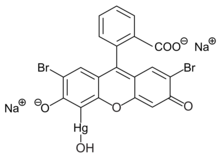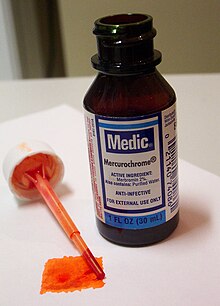
| |

| |

| |
| Names | |
|---|---|
| IUPAC name
dibromohydroxymercurifluorescein
| |
| Identifiers | |
3D model (JSmol)
|
|
| ChEBI | |
| ChEMBL | |
| ChemSpider | |
| DrugBank | |
| ECHA InfoCard | 100.004.486 |
| EC Number |
|
| KEGG | |
PubChem CID
|
|
| UNII | |
CompTox Dashboard (EPA)
|
|
| |
| |
| Properties | |
| C20H8Br2HgNa2O6 | |
| Molar mass | 750.658 g·mol−1 |
| Appearance | dark red liquid |
| Pharmacology | |
| D08AK04 (WHO) | |
| Hazards | |
| Occupational safety and health (OHS/OSH): | |
Main hazards
|
Toxic, dangerous for the environment |
| GHS labelling: | |
  
| |
| Danger | |
| H300, H310, H330, H373, H410 | |
| P260, P264, P273, P280, P284, P301+P310 | |
Except where otherwise noted, data are given for materials in their standard state (at 25 °C [77 °F], 100 kPa).
| |
Merbromin (marketed as Mercurochrome, Merbromine, Mercurocol, Sodium mercurescein, Asceptichrome, Supercrome, Brocasept and Cinfacromin) is an organomercuric disodium salt compound used as a topical antiseptic for minor cuts and scrapes and as a biological dye. Readily available in most countries, it is no longer sold in Switzerland, Brazil, France, Iran, Germany, Denmark, or the United States, due to its mercury content.[1][2]
